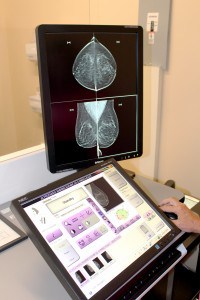Most women know annual screening is the best way to detect breast cancer early. It gives them better odds of successful treatment and a full recovery.
But not everyone realizes that might mean getting more than an annual mammogram.
The team at Regional One Health’s East Campus Imaging Center says some patients should also have a breast ultrasound. Board-certified Diagnostic Radiologist Timothy Cramer, MD said patients with dense breasts need both tests.
Dense breast tissue is not abnormal or harmful. However, cancer can “hide” in dense tissue because they look the same on a mammogram image. On an ultrasound, diagnostic radiologists can see what they can’t see on the mammogram.
“If you have very dense breasts, an ultrasound and a mammogram together can help with detection at any age,” Dr. Cramer said.
Here are their tips to help women get the most out of their annual screening:
Ask your doctor about breast density
Women should find out about dense breast tissue when they get their baseline mammogram at age 40. The disclosure is state law. Women must be told dense tissue increases their risk of breast cancer and makes mammogram results harder to read.
Dr. Cramer said you are more likely to have dense breasts if:
- You’re young
- You have low body fat
- You take hormone therapy for menopause
Dr. Cramer’s advice: Make sure your physician tells you if you have dense breast tissue. Ask them to discuss your optimal annual screening plan.
Understand your screening options
Dr. Cramer explained why adding an ultrasound is best for some women.

Regional One Health’s East Campus Imaging Center uses the latest in mammogram and ultrasound technology.
A mammogram uses regular x-ray technology. Fatty tissue shows up as gray and dense tissue shows up white. A cancerous tumor would also show up as white.
Ultrasound uses sound waves that bounce off tissue. Different tissue makes very different echo patterns. For example, a fluid-filled cyst looks different than a solid tumor.
Dr. Cramer said radiologists correlate mammograms and ultrasounds. The mammogram shows them a full picture of the breast and where the dense tissue is located. The ultrasound focuses in on that dense tissue and shows what lies within it.
A needle biopsy is still the only way to test for cancer. But, ultrasound shows if there is a suspicious mass within regular dense tissue.
Dr. Cramer’s advice: breast ultrasound is a companion, not an alternative, to mammography. A diagnostic radiologist should read the results of the two tests simultaneously. All of the East Campus radiologists have special certification in reading breast imaging.
Schedule an appointment today
At the East Campus, mammograms and breast ultrasounds are easy to schedule.
Walk-in mammograms are available Monday-Friday from 8 a.m. to 4 p.m. Women don’t need a doctor’s order for a preventative screening mammogram.
Breast ultrasounds do require a doctor’s order. The test is easy to schedule at the East Campus.
